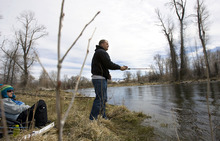This is an archived article that was published on sltrib.com in 2011, and information in the article may be outdated. It is provided only for personal research purposes and may not be reprinted.
Utah's mercury work group might be having an identity crisis.
In light of the Great Salt Lake's dubious status as among the natural water bodies with the nation's highest levels of poisonous methylmercury, the panel was organized six years ago to learn the extent of Utah's toxic mercury problem and to suggest possible solutions.
But, at its latest meeting, the panel wondered aloud Thursday if it's making much difference.
"Does anyone think we've done enough to clean up mercury?" asked board member Bruce Waddell, a retired U.S. Fish and Wildlife Service ecologist.
No answer came quickly, and there are a number of reasons why.
For one, the effort has been starved for funding, since state budget-makers have dedicated little funding to the problem in years.
The agencies involved — the divisions of Water Quality, Air Quality, Wildlife Resources, Environmental Response and Remediation along with the Department of Health — have cobbled together money for studies largely with the help of federal grants.
A $50,000 mercury analyzer purchased a few years ago allowed researchers to determine how much methylmercury is in the muscles of fish and waterfowl. But it's been idle for years because the Health Department has no staff to run the tests.
The panel even canceled a meeting last year. They had nothing to talk about. And many members failed to show up for Thursday's session. Among the no-shows were representatives from federal wildlife offices, the medical community, the state air-quality office and other key stakeholders.
Efforts to determine where the mercury comes from — one hunch was that it drifted in from Nevada's gold mining operations — have been all but abandoned. So has the idea of setting a limit on mercury discharges to the Great Salt Lake from cleanup of old mining waste on the Salt Lake Valley's west side.
John Whitehead, deputy director of state water-quality programs and leader of the workgroup, said he sympathized with frustration expressed by Waddell and others. Shrinking state budgets for environmental programs, he said, has been a big problem.
"We can barely keep ongoing programs going, let alone start something new," like mercury pollution, Whitehead said.
Still, there have been successes, he noted.
Tissue from some 2,500 fish have been analyzed over the span of a dozen years, leading to public advisories aimed at limiting the harm from high mercury levels.
Elevated mercury has prompted fish consumption advisories at 14 sites. And suggested consumption limits were issued for three species of waterfowl.
The U.S. Environmental Protection Agency continues to do tissue-sampling for Utah and recently provided the state with two years of data that will help determine if more advisories are needed. A study of mercury's impact on breeding birds in the Great Salt Lakes is in the final stages.
And early projections are promising for a new method of reducing methylmercury in Newcastle Reservoir, where the wipers are so contaminated they have been declared unsafe to eat. The U.S. Geological Survey plans to use a solar pump to churn the water so there's less buildup of toxic methylmercury.
Waddell said too many questions remain despite the progress.
"I don't want a happy face to be put on these things," he said, "when there's not a happy face."
Utah consumption advisories for fish and waterfowl
Water bodies are listed alphabetically with species of fish and contaminant. Visit http://www.fishadvisories.utah.gov for more information.
Calf Creek in Garfield County • brown trout; mercury
Green River in Desolation Canyon in Carbon County • catfish; mercury
East Fork Sevier River between Otter Creek and Piute Reservoirs in Piute County • brown trout; mercury
Gunlock Reservoir in Washington County • largemouth bass; mercury
Joe's Valley Reservoir in Emery County • splake trout; mercury
Jordanelle Reservoir in Wasatch County • brown trout and smallmouth bass; mercury
Mill Creek in Grand County • brown trout, mercury
Newcastle Reservoir in Iron County • rainbow trout; mercury
Pine Creek in Garfield County • brown trout; mercury
Porcupine Reservoir in Cache County • brown trout; mercury
Rock Creek below Upper Stillwater Reservoir in Duchesne County • brown trout; mercury
Sand Hollow Reservoir in Washington County • largemouth bass; mercury
Upper Enterprise Reservoir in Washington County, • rainbow trout; mercury
Weber River in Morgan County • brown trout; mercury
In addition, the Utah Department of Health and the Utah Division of Wildlife Resources advise against eating Common Goldeneye, Cinnamon Teal and Northern Shoveler ducks because of mercury contamination.
Source: http://www.fishadvisories.utah.gov What's the problem with mercury?
Mercury transforms into toxic methylmercury in the environment and builds up in the food chain. People are at greatest risk when they eat contaminated meat, either fish or waterfowl.
Women of child-bearing age and children are most at risk, since mercury attacks developing brains and nervous systems.
State health and environment officials have warned Utahns to eat less fish, or none, from 14 lakes and rivers because of mercury contamination. The Great Salt Lake, which has some of the highest levels of methylmercury ever measured, does not contain any fish. In addition, there are consumption warnings for three species of waterfowl hunted in the wetlands around the Great Salt Lake, the first consumption advisories of the kind in the nation.



